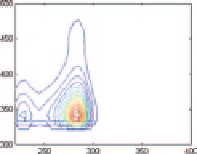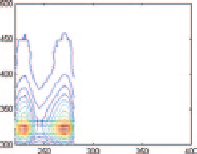Environmental Engineering Reference
In-Depth Information
Peak W
Peak A
Peak T
UV
(c
′
)
(b
′
)
(d
′
)
(e
′
)
Peak T
UV
Peak T
The fluorescent components of commercial or household detergents (
b
′,
c
′) indentified using
PARAFAC modeling on EEM data of its aqueous samples (
Data source
Mostofa et al.
2010
). The
fluorescent components of lake green algae (
d
′,
e
′) isolated and resuspensions in aqueous media
(Milli-Q and river waters) identified using PARAFAC modeling on respective EEM data (
Data source
Mostofa KMG et al., unpublished data).
component (T
UV
-like) is refractory to photoinduced degradation but it is labile to
microbial degradation (Mostofa et al.
2010
). The form and composition of deter-
gents is variable and recently includes synthetic or naturally occurring polymers
with molecular weight ranging from <1000 to >1,000,000 Da (McCullen
1996
).
Surfactants can have different functionalities (anionic, nonionic and cationic) and
commonly used commercial ones are linear alkylbenzene sulphonates, alkyl eth-
oxy sulphates, alkyl sulphates, alkylphenol ethoxylates, akyl ethoxylates, and qua-
ternary ammonium compounds (McCullen
1996
; Ying
2006
).
Algae or Phytoplankton
Algae or phytoplankton show several peaks such as 280-285/340-346 nm at peak
T-region and 230/327-346 or 230/305 nm at peak T
UV
T-region when resuspended in
water (Tables
1
,
2
) (Mostofa KMG et al., unpublished data; Determann et al.
1998
).
PARAFAC modeling on the EEM spectra of algae in Milli-Q water show the two
fluorescent components of algae (Fig.
3
d′, e′; Table
2
). The first algae component
has a strong fluorescence peak at Ex/Em
=
280-285/340-346 nm (peak T-region)
and at 230/346 nm (peak T
UV
-region) (Fig.
3
d′), and is similar to the protein-like
component that has a much more intense fluorescence at peak T-region than at
peak T
UV
-region (Fig.
3
m, n). The second fluorescent component of algae shows
a fluorescence peak at Ex/Em
=
270/327-336 nm (peak T-region) and at 230/327-
336 nm (peak T
UV
-region) (Fig.
3
e′; Table
2
). The algae or bacteria collected from
marine waters can exhibit fluorescence at Ex/Em
=
280/340 nm (peak T-region)












